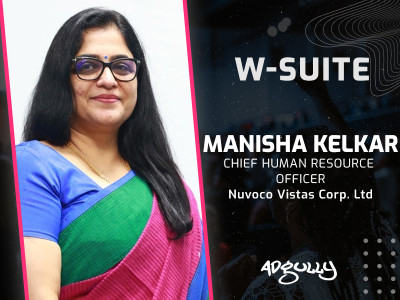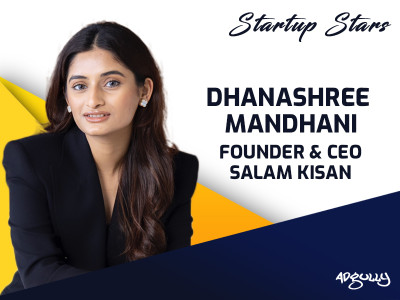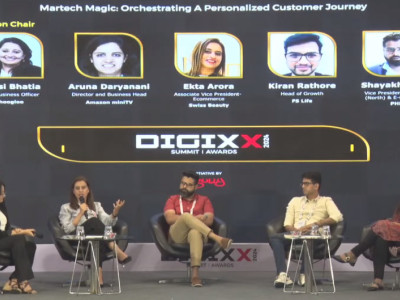Manisha Kelkar’s mantra for promoting gender diversity in leadership
Adgully has consistently celebrated and acknowledged the accomplishments of women entrepreneurs and leaders in various sectors. One of our notable initiatives, W-SUITE, focuses on highlighting extraordinary women achievers in the Media & Entertainment, Advertising, Marketing, PR, and Communications industry. In this updated series, we aim to explore how women leaders adeptly manage their teams and overcome challenges in the dynamic landscape of their respective industries.
Stage is set for the fifth edition of WOMEN DISRUPTORS Summit & Awards 2024, to be held on March 1. With the theme of ‘Driving forward positive change in transformative times’, Adgully’s WOMEN DISRUPTORS 2024 seeks to straddle the changing world and unleash the true potential that India’s women workforce drive.
In an exclusive interaction with Adgully, Manisha Kelkar, Chief Human Resources Officer (CHRO), Nuvoco Vistas Corp. Ltd, speaks about her transformative journey in the company, navigating the complexities of work-life balance, promoting gender diversity in leadership, and much more.
Could you take us through your journey at Nuvoco Vistas Corp? What are the major milestones achieved on your journey so far?
Certainly, my tenure at Nuvoco Vistas Corp. Ltd. has been a dynamic and transformative journey, characterised by several pivotal milestones that have shaped not only my career but also the trajectory of the organisation.
Commencing with the initial milestone, my transition from a non-cement sector to spearheading the organizational development agenda was a crucial phase. During this period, my focus was on orchestrating OD interventions with the top leadership team, preparing the organization for exponential growth by increasing the involvement of all managers in the development journey and fostering a cultural shift within the organisation. The impact of these interventions garnered recognition not only at the national level but also on the global stage.
The second milestone centered around the integration of cement and ready-mixed businesses in India. In this role, I ensured the seamless integration of new businesses, establishing a new country structure and management team, and maintaining uniform HR processes across businesses for enhanced employee experience.
The third milestone was the acquisition by Nirma, which involved navigating the transition during the takeover and shaping Nuvoco Vistas Corporation Limited. Working collaboratively with the team, we defined the organisation’s name, vision, mission, and values, and cascaded them across the organisation. Building brand awareness for Nuvoco and maintaining its reputation was a key facet of this milestone.
Following this, the fourth milestone involved my personal transition from an OD role to the position of Chief Human Resources Officer (CHRO). Undertaking this role offered me a position to influence the entire HR agenda, contribute to the executive committee team, and play a pivotal role in shaping the broader organizational agenda. This transition expanded my purview from HR to the holistic business landscape, enabling me to define HR priorities and drive the HR agenda effectively.
Lastly, the fifth milestone unfolded during the unprecedented challenges of COVID-19, with the acquisition of Emami Cement. Managing this acquisition virtually, devoid of the ability to travel or meet in person, presented distinctive challenges. However, the team’s resilience prevailed as we successfully navigated these hurdles, exemplifying our commitment to seamless integration even amidst the pandemic.
These five milestones encapsulate the transformative journey I have undergone at Nuvoco Vistas, contributing to the organisation’s growth and resilience in the face of evolving landscapes.
As a woman leader, what are the challenges you have faced?
As a female leader, entering a factory setting, particularly the shop floor with a union, presented distinct challenges. The hurdles weren’t solely related to my gender, but also stemmed from being a newcomer in an environment where preconceptions needed to be addressed. As a management trainee, moving through the shop floors led to questions from others such as, “Why is she here? What is her role?” This posed a dual challenge – establishing HR’s impact on the shop floor and challenging gender norms regarding women working in such contexts. Navigating this journey successfully involved maintaining strictly professional interactions. Whether on the shop floor or in a room predominantly occupied by men, keeping conversations professional was paramount. However, when discussions touched upon our shared agenda, I didn’t hesitate to express my passion. This approach allowed others to see beyond initial perceptions and comprehend the purpose behind my presence.
Overcoming this challenge was not only a journey for them, but also a personal one for me. Once I surpassed this mental barrier, collaboration with others became more seamless. This adjustment was a one-time process upon entering the corporate world, and since then, I have not encountered similar challenges.
What is your mantra for maintaining an effective work-life balance?
In navigating the complexities of work-life balance, I adhere to a mantra that draws inspiration from established management principles, specifically the renowned 80-20 principle or Pareto analysis. I firmly believe that these management jargons aren’t merely for presentations, but offer practical and insightful guidance.
In my experience, the 80-20 principle holds true in real-life scenarios. By maintaining absolute clarity about priorities and channeling efforts into the crucial 20% of tasks that yield 80% of the desired results, one can significantly enhance work-life balance. The essence lies in the ability to discern priorities and, importantly, having the clarity to say no to tasks that do not align with overarching objectives. This approach allows me to maintain a harmonious equilibrium between professional commitments and personal life.
Who is a great leader according to you? What do think makes women great leaders in today’s times?
When reflecting on great leadership, the teachings of J. Krishnamurti have been instrumental in shaping my beliefs. His profound insights have provided a guiding light in my understanding of leadership principles.
As for women leaders, while I haven’t specifically followed any individual, I am open to exploring diverse perspectives and learning from the experiences of accomplished women leaders. In today’s dynamic times, I believe what makes women great leaders is their unique ability to bring diverse viewpoints to the table, foster inclusivity, and navigate complexities with empathy and resilience.
In the realm of corporate leadership, the landscape is continuously evolving, and I find myself intrigued by the innovative approaches of emerging leaders. The ability to adapt to change, embrace diversity, and foster a collaborative and forward-thinking culture are qualities that I appreciate in leaders shaping the future of the corporate world.
What are the lessons you learned from the pandemic period? How do you think the scope and role of women leaders have widened in the current market ecosystem?
The pandemic period brought forth a profound lesson that underscored the importance of trust and faith in individuals. Initially hesitant to bring up the pandemic, I realised its fundamental impact on highlighting the value of collaboration and mutual support. Witnessing everyone’s dedication to going above and beyond their roles for collective well-being was genuinely remarkable. It fostered a communal ethos of “Tell me what I can do sitting at home”, transcending hierarchies and job descriptions. This experience solidified my belief in the power of collaboration and the inherent kindness within people. Concerning the expanded breadth of women leaders in the contemporary market ecosystem, the theme resonates deeply, especially when considering the critical role played by mothers during this difficult moment.
As we consider the current market ecosystem, the expanded scope and role of women leaders resonate deeply. The unique qualities women bring to leadership, such as empathy, resilience, and adaptability, became even more evident during challenging times. The pandemic showcased the crucial role played by women, especially mothers, who seamlessly juggled professional responsibilities with caregiving duties. This period emphasised the indispensable value of diverse leadership styles and perspectives, affirming the significant and ever-widening impact of women leaders in today’s dynamic and challenging market environment.
How do you think more women can be encouraged for leadership roles? What is your mantra?
Encouraging more women to take on leadership roles is essential for fostering diversity and enriching the workplace. My mantra for promoting gender diversity in leadership is centered on creating an inclusive and supportive environment.
To achieve this, organisations can implement mentorship and sponsorship programs, providing aspiring women leaders with guidance, opportunities, and a platform to showcase their capabilities. Additionally, establishing clear pathways for career advancement and recognising and celebrating the achievements of women leaders can contribute to a more inclusive workplace culture.
I believe in fostering a workplace environment that values diverse perspectives and recognises the unique strengths that women bring to leadership roles. The mantra is simple: empower, support, and celebrate the potential of every individual, irrespective of gender, creating a workplace where talent and leadership thrive.
How can women be encouraged to step into leadership roles considering their multifaceted responsibilities in both professional and personal spheres?
Encouraging women to step into leadership roles, given their multifaceted responsibilities in both professional and personal spheres, requires a strategic approach that begins with demystification. Breaking down the perceptions associated with senior roles is a fundamental step in this process.
One key aspect is to emphasise that transitioning into a senior leadership position doesn’t necessarily equate to an increase in individual responsibilities, longer working hours, heightened stress levels, or frequent boardroom battles. Instead, it involves a shift towards mentoring, reviewing, and inspiring others. It's about making a positive impact by motivating and leading, rather than solely managing individual tasks.
By dispelling the myth that senior roles automatically mean greater time commitments and stress, we can provide a more accurate understanding of the responsibilities involved. This demystification is crucial for instilling confidence in women to consider leadership roles. Women should recognise that these roles offer opportunities to effect positive change and that the associated challenges can be managed effectively with the right support structures in place.
Ultimately, fostering a true understanding of leadership responsibilities can empower women to approach these roles with greater ease and confidence.
How do you typically motivate your team in your role as an HR professional?
As an HR professional, I have discovered that motivating teams comes more naturally within the HR domain than in other functions. My go-to strategy involves highlighting the direct impact of our collective efforts on the lives of employees.
When I convey to my team the tangible difference they make through their hard work – whether it is enhancing the work experience, addressing concerns, or facilitating growth – I observe an immediate boost in commitment. This emphasis on the real-world impact not only instills a sense of purpose, but also inspires everyone to go the extra mile.
By connecting our daily tasks to the positive changes, we bring to the lives of employees, I have found that motivation becomes more than just a workplace necessity; it becomes a shared commitment to fostering a positive and impactful work environment.


















Share
Facebook
YouTube
Tweet
Twitter
LinkedIn